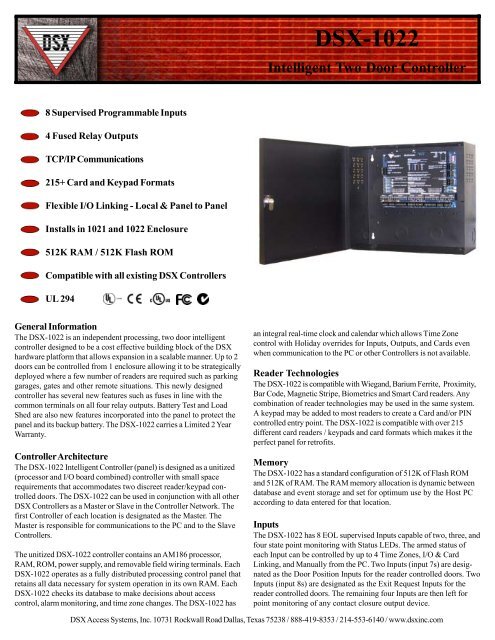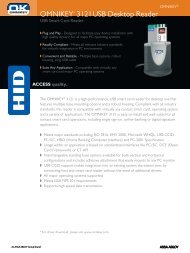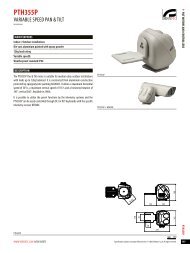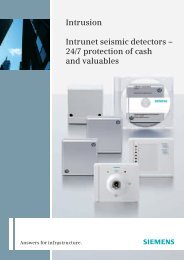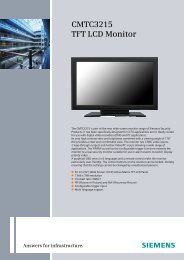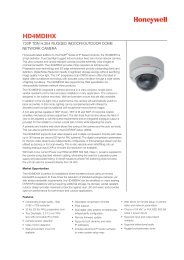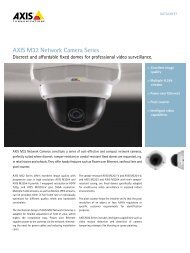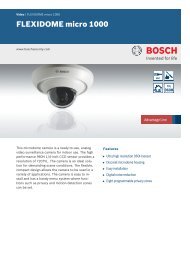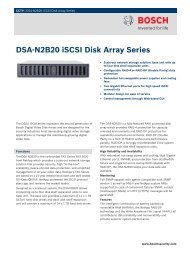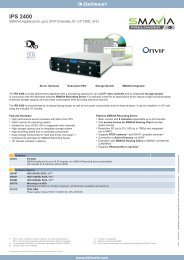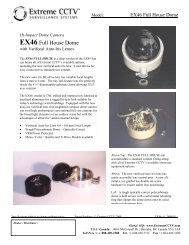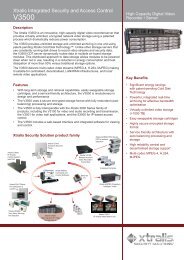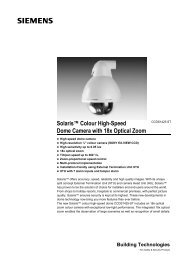DSX-1022 Intelligent Two-Door Controller - SAS Access Systems
DSX-1022 Intelligent Two-Door Controller - SAS Access Systems
DSX-1022 Intelligent Two-Door Controller - SAS Access Systems
You also want an ePaper? Increase the reach of your titles
YUMPU automatically turns print PDFs into web optimized ePapers that Google loves.
<strong>DSX</strong>-<strong>1022</strong><br />
<strong>Intelligent</strong> <strong>Two</strong> <strong>Door</strong> <strong>Controller</strong><br />
8 Supervised Programmable Inputs<br />
4 Fused Relay Outputs<br />
TCP/IP Communications<br />
215+ Card and Keypad Formats<br />
Flexible I/O Linking - Local & Panel to Panel<br />
Installs in 1021 and <strong>1022</strong> Enclosure<br />
512K RAM / 512K Flash ROM<br />
Compatible with all existing <strong>DSX</strong> <strong>Controller</strong>s<br />
UL 294<br />
General Information<br />
The <strong>DSX</strong>-<strong>1022</strong> is an independent processing, two door intelligent<br />
controller designed to be a cost effective building block of the <strong>DSX</strong><br />
hardware platform that allows expansion in a scalable manner. Up to 2<br />
doors can be controlled from 1 enclosure allowing it to be strategically<br />
deployed where a few number of readers are required such as parking<br />
garages, gates and other remote situations. This newly designed<br />
controller has several new features such as fuses in line with the<br />
common terminals on all four relay outputs. Battery Test and Load<br />
Shed are also new features incorporated into the panel to protect the<br />
panel and its backup battery. The <strong>DSX</strong>-<strong>1022</strong> carries a Limited 2 Year<br />
Warranty.<br />
<strong>Controller</strong> Architecture<br />
The <strong>DSX</strong>-<strong>1022</strong> <strong>Intelligent</strong> <strong>Controller</strong> (panel) is designed as a unitized<br />
(processor and I/O board combined) controller with small space<br />
requirements that accommodates two discreet reader/keypad controlled<br />
doors. The <strong>DSX</strong>-<strong>1022</strong> can be used in conjunction with all other<br />
<strong>DSX</strong> <strong>Controller</strong>s as a Master or Slave in the <strong>Controller</strong> Network. The<br />
first <strong>Controller</strong> of each location is designated as the Master. The<br />
Master is responsible for communications to the PC and to the Slave<br />
<strong>Controller</strong>s.<br />
The unitized <strong>DSX</strong>-<strong>1022</strong> controller contains an AM186 processor,<br />
RAM, ROM, power supply, and removable field wiring terminals. Each<br />
<strong>DSX</strong>-<strong>1022</strong> operates as a fully distributed processing control panel that<br />
retains all data necessary for system operation in its own RAM. Each<br />
<strong>DSX</strong>-<strong>1022</strong> checks its database to make decisions about access<br />
control, alarm monitoring, and time zone changes. The <strong>DSX</strong>-<strong>1022</strong> has<br />
an integral real-time clock and calendar which allows Time Zone<br />
control with Holiday overrides for Inputs, Outputs, and Cards even<br />
when communication to the PC or other <strong>Controller</strong>s is not available.<br />
Reader Technologies<br />
The <strong>DSX</strong>-<strong>1022</strong> is compatible with Wiegand, Barium Ferrite, Proximity,<br />
Bar Code, Magnetic Stripe, Biometrics and Smart Card readers. Any<br />
combination of reader technologies may be used in the same system.<br />
A keypad may be added to most readers to create a Card and/or PIN<br />
controlled entry point. The <strong>DSX</strong>-<strong>1022</strong> is compatible with over 215<br />
different card readers / keypads and card formats which makes it the<br />
perfect panel for retrofits.<br />
Memory<br />
The <strong>DSX</strong>-<strong>1022</strong> has a standard configuration of 512K of Flash ROM<br />
and 512K of RAM. The RAM memory allocation is dynamic between<br />
database and event storage and set for optimum use by the Host PC<br />
according to data entered for that location.<br />
Inputs<br />
The <strong>DSX</strong>-<strong>1022</strong> has 8 EOL supervised Inputs capable of two, three, and<br />
four state point monitoring with Status LEDs. The armed status of<br />
each Input can be controlled by up to 4 Time Zones, I/O & Card<br />
Linking, and Manually from the PC. <strong>Two</strong> Inputs (input 7s) are designated<br />
as the <strong>Door</strong> Position Inputs for the reader controlled doors. <strong>Two</strong><br />
Inputs (input 8s) are designated as the Exit Request Inputs for the<br />
reader controlled doors. The remaining four Inputs are then left for<br />
point monitoring of any contact closure output device.<br />
<strong>DSX</strong> <strong>Access</strong> <strong>Systems</strong>, Inc. 10731 Rockwall Road Dallas, Texas 75238 / 888-419-8353 / 214-553-6140 / www.dsxinc.com
Outputs<br />
The <strong>DSX</strong>-<strong>1022</strong> has six Outputs. <strong>Two</strong> Outputs (output 1s) are the Form-<br />
C, fused at 1 Amp, relay outputs to control the locks for the reader<br />
controlled doors. <strong>Two</strong> Outputs (output 2s) are also Form-C, fused at 1<br />
Amp, relay outputs that are programmed and used in the same ways as<br />
all other outputs. All Relay Outputs have 1A fuses in series with the<br />
Common terminal. <strong>Two</strong> Pre-Warn Outputs of the <strong>DSX</strong>-<strong>1022</strong> are used to<br />
indicate the controlled doors are being held open and about to go into<br />
alarm. If the door is locked, armed, and opened, the output pulses low<br />
starting at 1/3 of the door open too long time and changes to a steady<br />
low anytime the door is in alarm. These open collector outputs reset<br />
automatically when the door is closed.<br />
Communications:<br />
The <strong>DSX</strong>-<strong>1022</strong> <strong>Intelligent</strong> <strong>Controller</strong> can communicate with the Comm<br />
Server (Host PC) via TCP/IP, direct serial port, and dial-up modem.<br />
TCP/IP LAN Communications can be performed from the Win<strong>DSX</strong><br />
Comm Server PC to a Master <strong>Controller</strong>. The Win<strong>DSX</strong> Software without<br />
the use of any additional Hardware or Software will redirect what would<br />
typically be serial port communications to a TCP/IP address. A <strong>DSX</strong>-<br />
LAN(M) serial device at the Master <strong>Controller</strong> receives the communications<br />
over the LAN from the Win<strong>DSX</strong> PC and converts it to RS-232/RS-<br />
485 for the Master <strong>Controller</strong>. The end result is real time communications<br />
similar to that of a direct serial port connection.<br />
Direct Connect Communications to the PC from the Master <strong>1022</strong><br />
<strong>Controller</strong> is performed with the use of the MCI module which connects<br />
to the comm port of the PC and converts the RS-232 signal from<br />
the PC to RS-485. The RS-485 communications from the MCI to the<br />
Master utilizes two twisted pair cable for the data and one pair for<br />
power. The RS-485 output of the MCI will support up to 4000 feet of<br />
cable distance. The controller communicates with the PC at a default<br />
baud rate of 9600. As long as the communications signal arrives at the<br />
Master as RS-485 and RS-232 at the PC in an asynchronous, full duplex<br />
mode, operating at 9600 baud, the method of communication in<br />
between can be just about any mode of transport such as Direct Wire,<br />
T1, Lease Line, or Fiber Optics.<br />
Dial-Up Modem Communications from the <strong>DSX</strong>-<strong>1022</strong> Master <strong>Controller</strong><br />
to the PC utilizes a <strong>DSX</strong>-Modem and <strong>DSX</strong>-MCI module at the <strong>Controller</strong><br />
and a <strong>DSX</strong>-Modem at the PC. At the <strong>DSX</strong>-<strong>1022</strong> Master, the RS-485<br />
Host Communications Port connects to a <strong>DSX</strong>-MCI module which<br />
converts the RS-485 of the <strong>Controller</strong> to RS-232 for the Modem. The<br />
<strong>DSX</strong>-MCI and Modem derive power from the 12VDC output of the<br />
<strong>DSX</strong>-<strong>1022</strong> panel. The <strong>Controller</strong> will auto-dial to the PC all Alarm and<br />
supervisory conditions. The controller can also be programmed to dial<br />
the PC when its event buffer is 80% full.<br />
Panel to Panel Communications is a true point to point, regenerative,<br />
RS-485, 4-wire, communications method. This allows the panel to panel<br />
network communications to be regenerated at each controller providing<br />
up to 4000 feet of distance between controllers over two twisted pair<br />
cable. Panel to Panel communications can be configured in a series<br />
loop, star configuration, or both. Star configurations require a <strong>DSX</strong>-<br />
1035 Quadraplexor.<br />
<strong>DSX</strong>-<strong>1022</strong> Specifications<br />
Size<br />
Cabinet<br />
<strong>DSX</strong>-<strong>1022</strong><br />
Weight<br />
Cabinet<br />
11.00 lb.<br />
<strong>DSX</strong>-<strong>1022</strong> 1.60 lb.<br />
Package Total<br />
12.60 lb.<br />
15.5” W x 13.5” H x 6.0”D<br />
10.5” W x 7.5” H x 1.5” D<br />
Finish<br />
Black Powder Coat on Enclosure and Black Enamel on Shield<br />
Temperature/Humidity<br />
Operating<br />
Storage<br />
32 to 131 F / 0 to 95%, relative<br />
-35 to 150 F<br />
Supply Voltage<br />
Panel Voltage<br />
16.5 VAC 40VA<br />
Power Requirements 33 Watts (112.6 BTU)<br />
Panel Current Draw 540 ma (Current will vary depending on panel voltage<br />
output loads).<br />
UL Listed or CSA Certified Class II Transformer Required.<br />
Output Voltage<br />
Panel Output<br />
Panel Output<br />
12VDC1A - Fused<br />
5VDC 1/2A - Fused<br />
Inputs<br />
EOL Supervised 8<br />
Inputs 5 through 6 are used for point monitoring.<br />
Inputs 7 and 8 are used for door position and exit request monitoring.<br />
All Inputs support two, three, and four state monitoring with five programmable<br />
circuit types.<br />
UL Installations require a Tamper Switch to be connected to an Input<br />
programmed with a 24hr Time Zone.<br />
Outputs<br />
Form C Relays (1-2)<br />
Relay Ratings<br />
LED Outputs<br />
Pre-Alarm Outputs<br />
4 fused at 1A<br />
5 AMP 30 VDC<br />
6 - 3 per reader - open collector 100ma<br />
2 - 1 per door - open collector 100ma<br />
<strong>Access</strong> Controlled Entry Points<br />
Card Reader or Keypad 2<br />
Any combination of card readers, keypads, or card and keypad controlled entry<br />
points may be used.<br />
Battery Charging Output<br />
Trickle Charge<br />
13.5 VDC 500ma Fused<br />
Standby Time<br />
3.3 hours under maximum load.<br />
For UL Installations, battery must be Powersonic PS-1270, Interstate<br />
PC-1270, or a SBS S-1272.<br />
Communication Ports<br />
RS-485 In 2 1 for Master to PC, 1 From Slave<br />
RS-485 Out 1 To Subsequent Slaves<br />
<strong>DSX</strong>-<strong>1022</strong> Master <strong>Controller</strong>s always require a MCI Module.<br />
Processor<br />
AM186<br />
20Mhz<br />
RAM Memory<br />
Standard<br />
512K<br />
* The transaction buffer automatically adjusts to utilize any RAM not allocated<br />
for system parameters.<br />
Warranty<br />
Limited 2 Years <strong>1022</strong>/0906.p65<br />
<strong>DSX</strong> <strong>Access</strong> <strong>Systems</strong>, Inc. 10731 Rockwall Road Dallas, Texas 75238<br />
888-419-8353 Phone 214-553-6140 Phone 214-553-6147 Fax www.dsxinc.com


